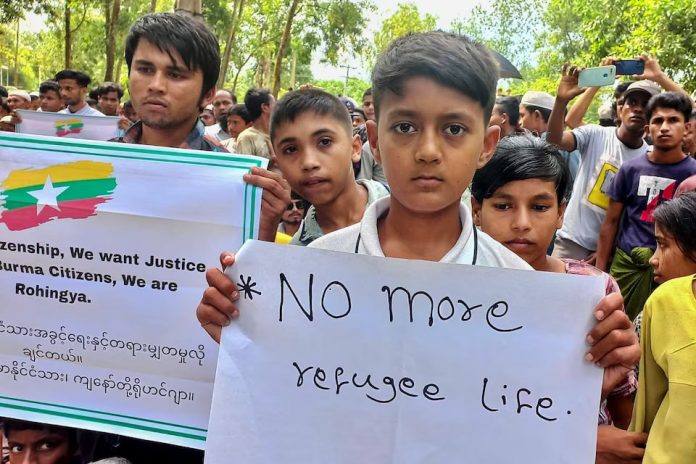Some Rohingya living temporarily at refugee camps in Bangladesh have been returning to their villages and towns in northern Arakan (Rakhine) State with their families due to the increasing hardships faced by life in the camps, according to a Rohingya refugee currently staying at Kutupalong camp who spoke to DMG.
The World Food Programme (WFP) was previously providing each Rohingya refugee in Bangladesh with a monthly allowance of $12.50 USD, but this was reduced to $6 USD per month in April.
This has made the lives of the Rohingya in the refugee camps, who were already suffering from livelihood challenges, even harder. As a result, some of them have decided to return to their homeland in Arakan.
“Refugees aren’t allowed to leave the camp to work outside. For families with many members and children, the WFP support just isn’t enough. That’s why some families have started returning to their native Arakan,” the Rohingya refugee told DMG on the condition of anonymity.
“But for now, it’s still just a small number. Only those who are sure they can’t survive here any longer choose to go back,” he added.
Reports have also suggested that some Rohingya refugees are returning to Myanmar because they were harassed and intimidated by Rohingya armed groups operating in the refugee camps.
The International Crisis Group (ICG) released a report on June 18 titled: “Bangladesh/Myanmar: The Dangers of a Rohingya Insurgency.” It states that Rohingya armed groups are recruiting and training young Rohingya from the refugee camps to fight the Arakan Army (AA).
The ICG report warned that such activities could escalate tensions between the AA and the Bangladeshi authorities and potentially delay Dhaka’s plans for Rohingya repatriation.
Bangladeshi officials denied the ICG report’s claims and said there were was no recruitment or military activities in the refugee camps, in an interview with the Dhaka Tribune.
The exact number of Rohingya refugees who have returned to Myanmar is still unknown.
They are now living in villages such as Mingalar Gyi, U Shint Kya, U Thula, Kyauk Hlegar, and Lakeya in northern Maungdaw Township, as well as in several villages in Buthidaung Township.
The entire Myanmar-Bangladesh border, including Maungdaw and Buthidaung, where the Rohingya have returned to is now controlled by the AA. But, it seems even the AA has no clear idea of how many Rohingya have returned to Myanmar, though it has managed to verify and count some of them, according to a source close to the AA.
“They [the Rohingya refugees] came back planning to settle in Rohingya villages in northern Maungdaw Township. Some were checked by AA officials, but others slipped through without being verified,” the AA source told DMG on the condition of anonymity.
In 2017, following a military crackdown on Rohingya over 700,000 fled their homes in Arakan into Bangladesh. In 2024, three years after the 2021 military coup, fighting between the AA and the Myanmar military intensified which caused an additional 150,000 Rohingya to seek refuge in Bangladesh, according to the U.N.
Currently there are 1.2 million Rohingya from Myanmar living in temporary shelters at refugee camps in Bangladesh, according to Dhaka.
Prior to the 2021 coup, the National League for Democracy (NLD) government attempted to repatriate Rohingya from the camps in Bangladesh. The regime in Naypyidaw, which seized power after the coup, has agreed to accept Rohingya refugees. But, so far, there has been no significant progress on Rohingya repatriation.



